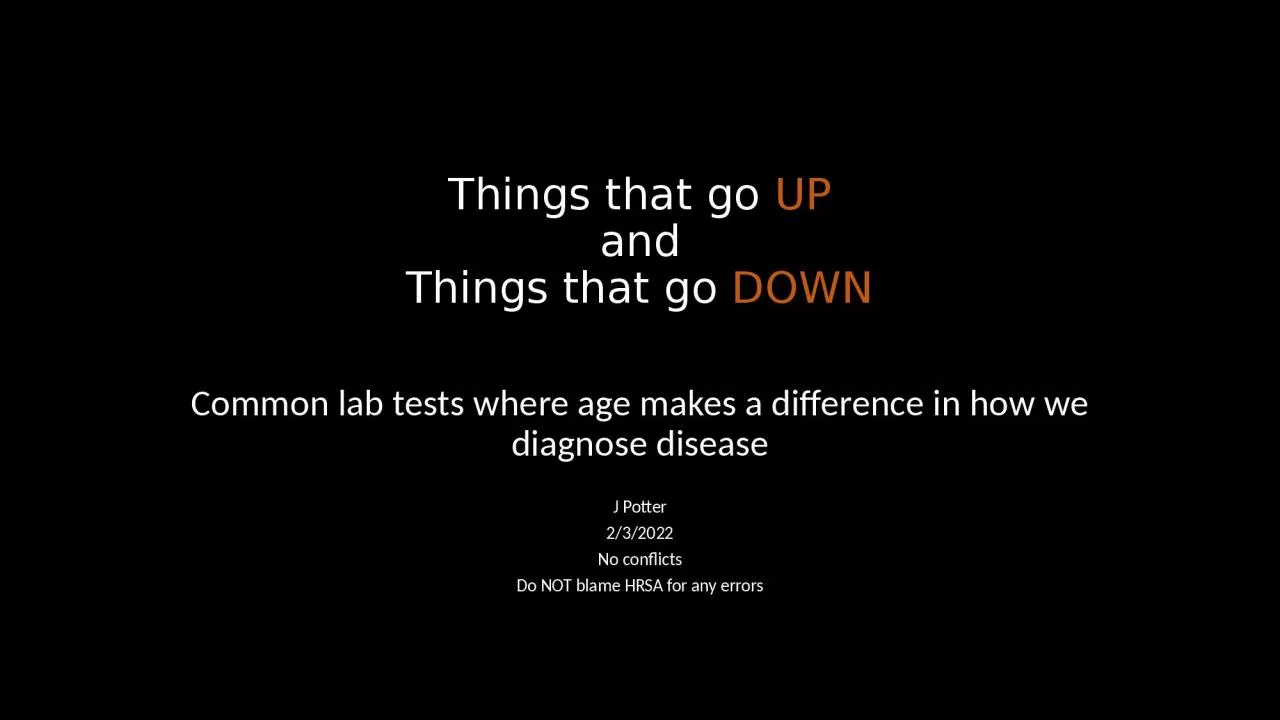

DOWN Common lab tests where age makes a difference in how we diagnose disease J Potter 232022 No conflicts Do NOT blame HRSA for any errors Background We are most like each other when we are young ID: 930281
Download Presentation The PPT/PDF document "Things that go UP and Things that go" is the property of its rightful owner. Permission is granted to download and print the materials on this web site for personal, non-commercial use only, and to display it on your personal computer provided you do not modify the materials and that you retain all copyright notices contained in the materials. By downloading content from our website, you accept the terms of this agreement.
Slide1
Things that go UPandThings that go DOWN
Common lab tests where age makes a difference in how we diagnose disease
J Potter
2/3/2022
No conflicts
Do NOT blame HRSA for any errors
Slide2Background We are most like each other when we are youngWe become more different as we age.Heterogeneity
is the rule
We can only speak about average or usual changes
2-Hour Post Prandial glucose levels
+ 2 SD
- 2 SD
Slide3Variability with AGE and with FRAILTY
Slide4Which of the following goes UP with age?A. Serum B-12 B. Post-prandial Insulin C. Inflammatory markers
D. Serum creatinine
Slide5Effects of Increased Inflammation on Lab StudiesIncrease ESR*
upper limit of normal for age:
♀
(age+10)/2 ; ⚨ age/2
Increase CRP NOT out of the usual lab limits but in the upper normal range
Increase D-Dimer upper limit = age x10
Increase Alkaline phosphatase
Not more than twice normal
Slide6What else goes UP?HF peptide (due to change in renal function and age-related LV hypertrophy).
Patients >70 years
HF
very unlikely
if BNP<125pg/ml or NT-proBNP <35 pg/mlHF very likely
if BNP >500 pg/ml or NT-proBNP
>1200 pg/ml
Slide7Your patient is 70; you check her TSH and T4. What threshold of TSH* would prompt you to start thyroid replacement when the patient has a normal T4?
A. 6
mU
/L
B. 8 mU/LC. 10 mU
/LD. 12 mU/L
* Lab normal range 0.5-5.0
mU/L
Slide8What else goes UP?TSH TSH up to 20 with a normal T-4 is subclinical hypothyroidism; TX does not improve symptoms.
Ignore mild TSH elevation unless ≥10
1
Reduce replacement dose with age (decline in lean body mass)
1
NEJM
Slide9What else Goes up?PSA Prostate size increases with age.
Age-adjust
upper limits of normal in men
40-59 yrs 2.5 ng/ml60-69
yrs 4.5 ng/ml 70-79
yrs 6.5 ng/ml
Slide10Things that go DOWNRenal function
CrCl
goes down but serum Cr does not
*; eGFR not reliable without age adjustment2Drug dosing
often based on CrCL (e.g. bisphosphonates).Age-adjust doses of renally excreted drugs* Frail/malnourished Cr is falsely low
Glomeruli are Lost with Age
Age 20
Age 90
- 50 %
2
Annals Int Med, 2021
Slide11Things that go DOWNInsulin release to a glucose challenge; and insulin sensitivity
Expect higher random glucose levels;
May increase HbA1c to “prediabetic” levels
Prediabetes as an important entity is in question in older people
3
3
JAMA Int Med
Slide12Things that go DOWNTestosterone (and many other hormones)Do not diagnose hypogonadism
in older men based on low T-level without
Repeated and
unequivocally low
levels and Symptoms (low libido is most reliable see GAYF)
Slide13Things that go DOWNImmune function-Aging Reduces Immune Function: T Cells
Antibody formation by
B cells
, may also be altered with aging
Colonization of the bladder without infection is common (asymptomatic bacteriuria)
Slide14Things that go DOWN but not muchHemoglobinevaluate men when Hb<13
and women
<12
OR if Hb drops >=1 gm in a year.
Significance
Lower hemoglobin is associated with more severe disability, poorer mobility and cognition, frailty, and falls
Slide15How to think about Anemia in Later LifeCombined deficiencies are common in older adults;
Reasonable to check B
12
, folate, and iron in all cases.
MCV is not reliable in combined deficiency states.
Slide16Slide17*
*
eGFR: <30, 9% anemic; < 60, 1% anemic
Slide18What is the Most Common Cause of Anemia in Late Life?Iron deficiency anemiaAnemia of chronic kidney disease
Anemia of chronic inflammation
Unexplained anemia of the elderly
Slide19Differentiating Anemias of Chronic Inflammation, Chronic Kidney Disease, UAE, MDS, Iron Deficiency, and Mixed ACI/Iron Deficiency
Anemia Type
Ferritin, ng/mL
TSAT, %
ESR/CRP
Other Labs
% of All Late-Life Anemias
Anemia of chronic inflammation (ACI)
>100
>20
Elevated
1
Hb not<10; CrCl >30
6–26
Anemia of CKD
>100
>20
WNL
CrCl <30
2
4–11
Unexplained Anemia of the Elderly (UAE)
WNL
WNL
WNL
B
12
and folate WNL; Hb not <10
25–40
Myelodysplastic Syndrome (MDS)
WNL
WNL
WNL
Hb <10, +/- other cytopenias
?
Iron Deficiency
<30
Low
WNL
TSAT <20
15–30
Mixed Iron Deficiency and ACI
30–100
Low
Elevated
TSAT <20
?
Slide20ConclusionsThings that go UP and DOWN
Age adjust what is normal for your older patients when rules exist
-
ESR; BNP, TSH, D-Dimer, PSA, HF peptide
Caution in interpreting low testosterone levels
Don’t treat asymptomatic bacteriuriaDon’t chase borderline alk. phos. levels
Anemia
Anemia is common and increases morbidityEvaluate anemia in ♀ when Hb <12 and in ♂when Hb <13 or a drop of 1 gm/1-yearThe most common causes are UAE, followed by ACI, and iron deficiency
Slide21Thank YouQuestions and Comments
Slide22Figure Legend:Positive bias indicates overestimation; negative bias indicates underestimation. CKD-EPI = Chronic Kidney Disease Epidemiology Collaboration; CKiD = Chronic Kidney Disease in Children Study; EKFC = European Kidney Function Consortium; eGFR = estimated glomerular filtration rate; FAS = full age spectrum; mGFR = measured GFR.
Date of Download: 01/19/2022
https://www.acponline.org
From: Development and Validation of a Modified Full Age Spectrum Creatinine-Based Equation to Estimate Glomerular Filtration Rate [A Cross-sectional Analysis of Pooled Data]
Ann Intern Med. 2021; 174(2):183-191. doi:10.7326/M20-4366
Slide23Table 3. Reclassification of Participants by NRI in the External Validation Data Set With Use of the EKFC Equation Versus the KDIGO-Recommended Equations*†
The gain in reclassifying participants was significant in the young adult (
P
< 0.001) and older adult (
P
= 0.003) subgroups.